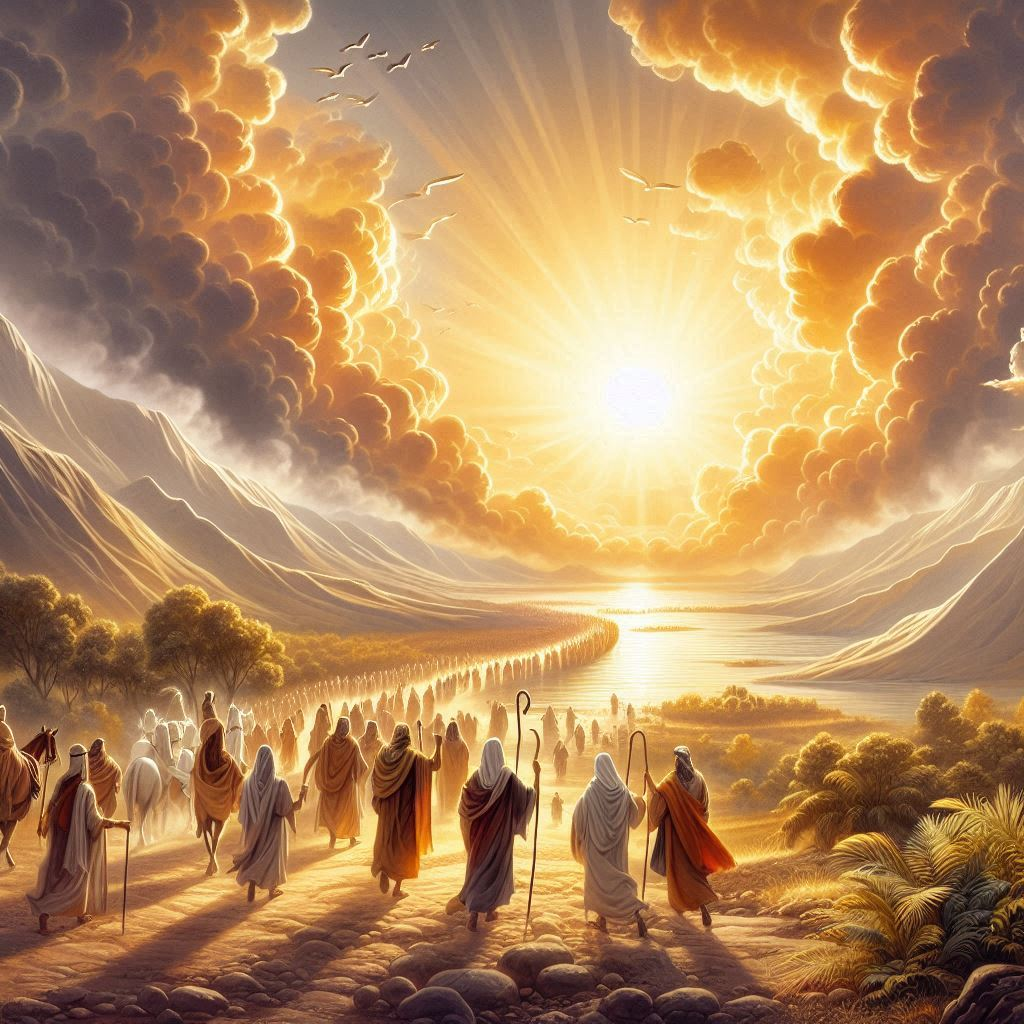Version: ESV – Lesallan

Exodus 13:17-14:14 (ESV): Detailed Analysis
Version: ESV
initial Observations & Questions
- The passage describes the journey of the Israelites from Egypt, guided by God through a pillar of cloud by day and a pillar of fire by night.
- What is the significance of the pillars of cloud and fire in guiding the Israelites?
- God hardens Pharaoh’s heart, leading him to pursue the Israelites.
- Why does God harden Pharaoh’s heart, and what is the purpose of this action?
- The Israelites are terrified when they see the Egyptians approaching.
- How does Moses reassure the Israelites in this moment of fear?
Structure
The passage can be divided into several sections: In the book of Exodus, it is recounted that God led the Israelites on a longer route to avoid conflict with the Philistines, showing concern for their safety. Additionally, the Israelites made sure to carry Joseph’s bones with them as they left Egypt, honoring his memory and legacy. Throughout their journey, God provided guidance and protection, manifesting as a pillar of cloud by day and a pillar of fire by night. As they camped by the sea, God hardened Pharaoh’s heart, which led to him pursuing the Israelites with his army. Witnessing Pharaoh’s approach, the Israelites were filled with terror, but Moses reassured them that God would fight for them, offering them hope and comfort in the face of adversity.
I. God Leads the Israelites on a Longer Route (Exodus 13:17-18, ESV)
God chooses a longer route to avoid war with the Philistines.
II. The Israelites Carry Joseph’s Bones (Exodus 13:19, ESV)
The Israelites fulfill Joseph’s request to carry his bones out of Egypt.
III. God Guides with a Pillar of Cloud and Fire (Exodus 13:20-22, ESV)
A. Pillar of Cloud by Day (Exodus 13:20-22, ESV)
God provides guidance and shade with a pillar of cloud.
B. Pillar of Fire by Night (Exodus 13:20-22, ESV)
God provides light and protection with a pillar of fire.
IV. God Instructs Moses to Camp by the Sea (Exodus 14:1-4, ESV)
God tells Moses to camp by the sea and hardens Pharaoh’s heart.
V. Pharaoh Pursues the Israelites (Exodus 14:5-9, ESV)
Pharaoh and his army pursued the Israelites after changing their minds.
VI. The Israelites are Terrified, and Moses Reassures Them (Exodus 14:10-14, ESV)
The Israelites fear the approaching Egyptians, and Moses reassures them that God will fight for them.
Words & Phrases
“Pillar of cloud by day/pillar of fire by night” (Exodus 13:22, ESV)
What is the significance of the pillars of cloud and fire?
The pillars symbolize God’s presence, guidance, and protection. The cloud provided shade and direction during the day, while the fire provided light and warmth at night.
“Glory” (Exodus14:4, ESV)
How does God gain glory through Pharaoh and his army?
God’s glory is demonstrated through His power and sovereignty. By hardening Pharaoh’s heart and orchestrating the events, God shows His supremacy over Egypt and reveals His might to the Israelites and the Egyptians.
“Changed their minds” (Exodus 14:5, ESV)
What caused Pharaoh and his officials to change their minds about letting the Israelites go?
Pharaoh and his officials realized the economic impact of losing their slave labor and regretted their decision, prompting them to pursue the Israelites.
“Terrified” (Exodus 14:10, ESV)
Why were the Israelites terrified when they saw the Egyptians?
The Israelites were trapped between the Red Sea and the approaching Egyptian army, leading to fear and panic. They felt helpless and doubted their escape.
“Be still” (Exodus14:14, ESV)
What does it mean to “be still” in this context?
Be still” means to remain calm and trust in God’s deliverance. Moses reassured the Israelites that God would fight for them and that they needed to have faith.
Summary, correlation, & application
The passage’s main point is that God guides, protects, and delivers His people, demonstrating His power and faithfulness.
This point arises from the narrative of God’s guidance through the pillars of cloud and fire, His strategic planning to avoid the Philistines and His ultimate deliverance of the Israelites from the Egyptians. The passage shows God’s active involvement in leading the Israelites and His ability to orchestrate events for their protection and deliverance.
This passage correlates with God’s deliverance and guidance throughout the Bible. For example, in Joshua 3, God parts the Jordan River to allow the Israelites to enter the Promised Land, mirroring the crossing of the Red Sea. Similarly, in Daniel 3, God protects Shadrach, Meshach, and Abednego in the fiery furnace, showcasing His power to save His people from seemingly impossible situations. These events collectively highlight God’s consistent faithfulness and sovereignty.
Personally, this passage encourages trust in God’s guidance and deliverance, even in the face of daunting challenges. It reassures that God is always present, guiding and protecting us, just as He did for the Israelites. For the local church, this passage serves as a reminder to rely on God’s direction and to have faith in His plans, especially during times of uncertainty or fear. For the broader Christian community, it underscores the importance of remembering and celebrating God’s past deliverances as a foundation for trusting Him in the present and future. This passage calls the church a beacon of hope, demonstrating unwavering faith in God’s power and faithfulness.
- How does this passage’s concept of divine guidance compare to other instances of God’s guidance in the Bible?
What can we learn about God’s character from His actions in this passage?
How might the Israelites’ experience of fear and deliverance be relevant to contemporary issues of faith and trust in God?
In what ways does this passage challenge or reinforce your understanding of God’s sovereignty and human responsibility?
- How can the themes of this passage be applied to situations of personal or communal crisis today?
- What role does memory and recounting past deliverances play in the faith journey of individuals and communities, as seen in this passage?
- How does the imagery of the pillars of cloud and fire enhance our understanding of God’s presence and protection?
- What are the implications of Moses’ leadership and his response to the Israelites’ fear of contemporary spiritual leadership?


4 Comments
businesstrick · September 10, 2024 at 10:56 am
I loved as much as youll receive carried out right here The sketch is attractive your authored material stylish nonetheless you command get bought an nervousness over that you wish be delivering the following unwell unquestionably come more formerly again as exactly the same nearly a lot often inside case you shield this hike
Tech to Force · September 11, 2024 at 1:12 pm
Tech to Force very informative articles or reviews at this time.
forbesblogs · September 12, 2024 at 1:35 pm
I was recommended this website by my cousin I am not sure whether this post is written by him as nobody else know such detailed about my difficulty You are wonderful Thanks
streameast · September 16, 2024 at 6:20 pm
I have been browsing online more than three hours today yet I never found any interesting article like yours It is pretty worth enough for me In my view if all website owners and bloggers made good content as you did the internet will be a lot more useful than ever before
Comments are closed.